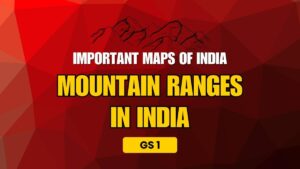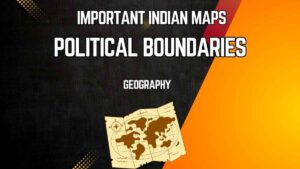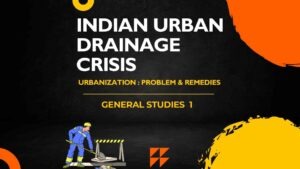Indian Urban Drainage Crisis
Indian Urban Drainage Crisis
🔹 In NEWS
Urban India is increasingly facing frequent flooding, especially during the monsoon season.
Cities like Delhi, Mumbai, and Bengaluru are witnessing recurring urban floods due to dysfunctional drainage systems, unplanned urbanisation, and climate change.
This has prompted renewed attention on sustainable urban flood management.
🔹 What is Urban Drainage?
Urban drainage involves the infrastructure and systems designed to collect, transport, and dispose of stormwater to avoid flooding.
This includes:
Stormwater drains
Natural water bodies
Recharge pits
Retention and detention systems
🔹 Key Statistics and Examples
⚠️ Over 70% of urban areas in India lack scientifically planned stormwater drains (MoHUA).
✅ Case Studies:
Mumbai:
Drains built in 1860s handle 25 mm/hour, but recent rains often exceed 100 mm/hour.
Lost 80% of its natural water bodies in the last 40 years.
Delhi:
Drainage system based on 1976 norms, designed for 50 mm/day.
185.9 mm rainfall in May 2025—9x above normal.
Bengaluru:
No natural river system.
65% of interconnected lakes encroached.
Bellandur and Varthur lakes are surrounded by concrete.
🔹 Causes Behind Urban Drainage Failures
🌀 Natural Causes
Climate Change-Induced Rainfall Extremes:
Short bursts of high-intensity rainfall becoming more common.
E.g., 2023: Delhi recorded 100 mm+ rainfall in under an hour.
Topography:
Low-lying areas like Mumbai, Chennai, Bengaluru are naturally flood-prone.
🏗️ Man-Made Issues
Unplanned Urbanisation:
Encroachment on floodplains, lakes, wetlands.
Concretisation reduces ground permeability, increasing runoff.
Outdated Design Norms:
Many systems designed for 1-in-2 year events, no longer suitable.
Illegal Constructions:
Encroachments and unauthorised drain covers hinder maintenance and desilting.
Sewage Infiltration:
No segregation of sewage and stormwater lines in many cities like Patna, Bhopal.
🔹 Government Initiatives
| Initiative | Key Features |
|---|---|
| Manual on Stormwater Drainage (2019) | Recommends designing for 1-in-5 to 1-in-10 year return periods. |
| AMRUT 2.0 | Promotes integrated stormwater networks & rejuvenation of water bodies. |
| Jal Shakti Abhiyan, Atal Bhujal Yojana | Focus on groundwater recharge, urban rainwater harvesting. |
| Model Building Bye-Laws (2016) | Mandates rainwater harvesting for plots >100 sq. m. |
| Amrit Sarovar Mission | Focus on reviving urban waterbodies for stormwater retention. |
| GIS-Based Mapping | Used in cities like Delhi for simulation-based redesign of drainage. |
🔹 Way Forward
✅ Structural Measures
Build underground rainwater storage tanks under parks, public spaces.
Create permeable pavements, bioswales, and green roofs.
✅ Regulatory & Planning Measures
Enforce zoning laws, MBBL, and environmental clearances strictly.
Integrate Drainage Master Plans with urban planning documents.
✅ Maintenance & Capacity Building
Ensure periodic desilting, inspection of covered and uncovered drains.
Capacity building in urban local bodies (ULBs) for flood-resilient planning.
✅ Community Participation
Launch public awareness drives on:
Responsible waste disposal
Rainwater harvesting
Preventing encroachment on lakes and drains
🧾 Conclusion
The urban drainage crisis in India is a product of outdated infrastructure, rapid and haphazard development, and increasing climate extremes. Tackling this crisis requires:
Multi-level governance coordination (Centre, State, ULBs)
Strict implementation of environmental and building laws
A shift from reactive flood response to resilience-based urban planning.
🧠 For Prelims – Quick Facts
| Topic | Fact |
|---|---|
| City with 1860s drainage | Mumbai |
| Rainfall in Delhi (May 2025) | 185.9 mm/day |
| % Urban Areas Lacking Proper Drains | 70%+ (MoHUA) |
| AMRUT Full Form | Atal Mission for Rejuvenation and Urban Transformation |
| MBBL Year | 2016 |
| Bellandur Lake | Encroached in Bengaluru, symbol of urban water mismanagement |
Mains-Based Questions on Indian Urban Drainage Crisis
1. In the context of increasing urban floods, critically examine the adequacy of India’s urban drainage infrastructure. (GS1/GS3)
Answer Framework:
Introduction:
Briefly define urban drainage infrastructure and mention the increasing incidence of urban flooding in cities like Delhi, Mumbai, Bengaluru.
Body:
A. Current Status and Inadequacies:
70% urban areas lack scientific drainage.
Outdated norms (e.g., Delhi’s 1976 standards).
Infrastructure not designed for high-intensity rainfall.
Loss of wetlands and natural drainage.
B. Causes:
Climate change – short-duration high-intensity rainfall.
Encroachment and concretisation.
Unregulated urban expansion.
C. Consequences:
Urban flooding, traffic paralysis, economic losses.
Health issues due to waterlogging and sewage mixing.
D. Government Efforts:
Manual on Drainage (2019), AMRUT 2.0, MBBL, GIS mapping, etc.
E. Way Forward:
Design for higher return periods, enforce bye-laws.
Nature-based solutions like wetlands, bioswales.
Periodic maintenance, ULB capacity building.
Conclusion:
Drainage must be seen not as an engineering issue alone but as an urban resilience issue in the climate risk era.
2. Has the rapid pace of urbanisation in India exacerbated the urban flooding problem? Discuss with examples. (GS1)
Answer Framework:
Introduction:
Define urbanisation and urban flooding.
Mention the recent urban flood events across Indian cities.
Body:
A. Link Between Urbanisation and Flooding:
Encroachment of lakes and wetlands (e.g., Bengaluru).
Concretisation reduces groundwater percolation.
Inadequate planning—cities grow faster than infrastructure.
B. Case Studies:
Mumbai – 80% wetlands lost; 1860s drains.
Bengaluru – Lakes interlinked earlier, now built over.
Delhi – Designed for 50 mm/day, now receiving 180+ mm/day.
C. Challenges:
Informal settlements on floodplains.
Fragmented governance, lack of integrated planning.
D. Solutions:
Sponge cities, urban wetlands, zoning regulation.
Integrated Urban Water Management (IUWM) principles.
Conclusion:
Urbanisation must be guided by sustainable planning to avoid climate-induced risks.
3. “The urban drainage crisis is as much a governance failure as it is an infrastructural one.” Analyse. (GS2/GS3)
Answer Framework:
Introduction:
Define urban drainage crisis; recent flood incidents show systemic failure.
Body:
A. Infrastructure Issues:
Outdated drainage.
Lack of capacity to handle current rainfall trends.
B. Governance Failures:
Overlapping jurisdiction between municipal bodies and development authorities.
Lack of enforcement of building bye-laws (e.g., MBBL 2016).
Poor data management and planning—only a few cities have GIS-mapped drainage.
C. Case Examples:
Unauthorized constructions in floodplains (Bengaluru, Patna).
Failure to desilt drains before monsoon.
D. Way Forward:
Strengthen ULBs with finances and expertise.
Unified urban flood management policy.
Adopt participatory governance involving citizens, RWAs.
Conclusion:
Infrastructure alone cannot solve what is essentially a problem of weak governance and enforcement.
4. Discuss how climate change is altering the urban hydrological cycle and what implications it holds for Indian cities. (GS3)
Answer Framework:
Introduction:
Climate change is intensifying the frequency and severity of rainfall events, affecting the urban water cycle.
Body:
A. Changes Observed:
Increase in short-duration, high-intensity rainfall.
Overflowing of urban drains and flash floods.
B. Implications:
Urban floods (Delhi 2025, Mumbai annually).
Health hazards due to mixing of sewage and rainwater.
Economic losses due to damage to infrastructure.
Overburdened civic systems.
C. Vulnerabilities:
Low-lying cities (e.g., Kolkata, Chennai, Mumbai).
Slum populations most affected.
D. Policy Responses:
City climate action plans.
Early warning systems.
Adoption of sponge city concepts, blue-green infrastructure.
Conclusion:
India’s urban planning must internalize climate risks and build future-proof infrastructure.
5. Examine the role of nature-based solutions in solving India’s urban drainage challenges. (GS3 – Environment/Infrastructure)
Answer Framework:
Introduction:
Define Nature-based Solutions (NbS) – using natural systems to solve urban challenges.
Body:
A. Urban Drainage Issues:
Encroachment of lakes, wetlands.
Rigid concrete systems are overwhelmed by rainfall.
B. Role of NbS:
Rejuvenation of wetlands (e.g., Amrit Sarovar Mission).
Permeable pavements to enhance percolation.
Green roofs, bioswales, retention ponds.
C. Global Examples:
China’s Sponge City Mission.
Singapore’s Bishan Park naturalisation.
D. Challenges:
Land scarcity.
Lack of interdepartmental coordination.
E. Recommendations:
Integrate NbS in Smart City and AMRUT 2.0.
Involve citizens in waterbody conservation.
Build capacity of ULBs in green infrastructure planning.
Conclusion:
NbS are not just environmentally sound, but cost-effective and climate-resilient solutions to India’s urban drainage woes.
Prelims Questions based on Indian Urban Drainage Crisis
-
Important Mountain Ranges in India
When preparing for UPSC, mapping is crucial. The exam often... -
Important Indian Maps – Political Boundaries
Important Indian Maps - Political Boundaries of India comprises of... -
Servants of India Society – Important UPSC Notes
Servants of India Society was founded by Gopal Krishna Gokhale.... -
Sea Level Rise at India’s Coastal Region – Important UPSC Notes
The World Meteorological Organization (WMO) released its State of the... -
Indian Urban Drainage Crisis – Important UPSC Notes
The post "Indian Urban Drainage Crisis" talks about the issue... -
Jayaprakash Narayan Important UPSC Notes
Commemorating the 51st anniversary of Jayaprakash Narayan’s (JP) “Total Revolution”... -
Sant Kabir Das – UPSC Notes
Sant Kabir Das Jayanti was celebrated on June 11, 2025,...








